Fermilab has an amazing presence on the Web. One of their sites is Fermilab at work. There’s a YouTube channel as well. There’s a splendid 10.5 minute video by Dr. Don Lincoln on “Why is the Weak Force weak?” Excellent graphics (including Feynman diagrams) and well presented.
Published on Apr 14, 2017 The subatomic world is governed by three known forces, each with vastly different energy. In this video, Fermilab’s Dr. Don Lincoln takes on the weak nuclear force and shows why it is so much weaker than the other known forces.
Here’re some excerpts from the transcript.
At a distance scale about the size of a proton, the strong nuclear force is the strongest. Electromagnetism is about one percent as strong as the strong force. And the weak nuclear force is only about 0.001 percent as strong as the strong force. Just why these forces have the strength they do is an interesting one and the answer differs, depending on the force. So, I thought I’d tell you why the weak force [mediated by W and Z bosons] is so much weaker than the electromagnetic force [mediated by photons] when they have so much in common. They’ve even been unified into a single force that we call the electroweak force, but that particular story I’ll leave for another day.
There’s a fascinating connection with the Uncertainty Principle and probabilistic mass of a particle in different interactions. A particle has a “natural” mass within a natural range, but its mass in extremely rare events can be quite different — much less: “a W particle is created with an outrageously unlikely mass.”
Basically what this is saying is that while a photon has zero mass, if the photon participates in an interaction that takes a very short time, for that split second, the photon might have a mass. Similarly, the Z boson has a nominal mass of 91 billion electron volts of energy, but its actual mass might differ in interactions that are very brief. This, of course, means that the mass [in electron volts] of the Z boson can vary from interaction to interaction. That’s a pretty mind blowing concept, but it’s true.
And because it almost never happens, then it is exceedingly unlikely that, for example, a carbon 14 nucleus will emit a W particle and decay. That means interactions that proceed by the weak force are very rare and THAT is why we call the weak force weak. It’s a matter of energy and the probability of making such a very light W particle. … The weak force is weak in radioactive decay because it can’t happen until a very rare W particle happens.
Other videos include:
The Weak Nuclear Force: Through the looking glass (excellent description of particle spin).
Published on Mar 10, 2017 Of all of the known subatomic forces, the weak force is in many ways unique. One particularly interesting facet is that the force differentiates between a particle that is rotating clockwise and counterclockwise. In this video, Fermilab’s Dr. Don Lincoln describes this unusual property and introduces some of the historical figures who played a role in working it all out.
The Weak Nuclear Force: Quantum Chameleon.
Published on Mar 23, 2017 Radioactive decay is the transmutation of one subatomic particle into another. In most instances, what happens is that existing particles move to new configurations. However in radioactive decays using the weak force, a particular kind of particle disappears and is replaced by a completely different particle. In this video, Fermilab’s Dr. Don Lincoln talks about how it all works and even describes a type of decay that has never been observed and, if it were observed, it would require the textbooks be rewritten.
Published on Feb 22, 2016 Fans of particle physics often encounter a series of doodles called Feynman diagrams. These mystifying scribbles were invented by Richard Feynman and they encode information on how particle physics collisions unfold. But they have an even deeper significance. In this video, Fermilab’s Dr. Don Lincoln gives you a peek into the deeper meaning of these important scientific pictograms.

